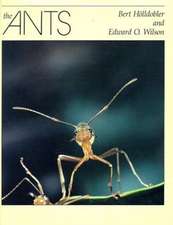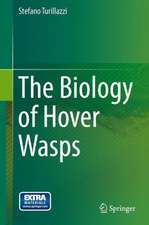Insect Olfaction
Editat de Bill S. Hanssonen Limba Engleză Paperback – 17 dec 2010
| Toate formatele și edițiile | Preț | Express |
|---|---|---|
| Paperback (1) | 2096.28 lei 6-8 săpt. | |
| Springer Berlin, Heidelberg – 17 dec 2010 | 2096.28 lei 6-8 săpt. | |
| Hardback (1) | 2102.76 lei 6-8 săpt. | |
| Springer Berlin, Heidelberg – 24 iun 1999 | 2102.76 lei 6-8 săpt. |
Preț: 2096.28 lei
Preț vechi: 2556.45 lei
-18% Nou
Puncte Express: 3144
Preț estimativ în valută:
401.10€ • 418.83$ • 331.23£
401.10€ • 418.83$ • 331.23£
Carte tipărită la comandă
Livrare economică 15-29 aprilie
Preluare comenzi: 021 569.72.76
Specificații
ISBN-13: 9783642084492
ISBN-10: 3642084494
Pagini: 468
Ilustrații: X, 458 p.
Dimensiuni: 155 x 235 x 25 mm
Greutate: 0.65 kg
Ediția:Softcover reprint of hardcover 1st ed. 1999
Editura: Springer Berlin, Heidelberg
Colecția Springer
Locul publicării:Berlin, Heidelberg, Germany
ISBN-10: 3642084494
Pagini: 468
Ilustrații: X, 458 p.
Dimensiuni: 155 x 235 x 25 mm
Greutate: 0.65 kg
Ediția:Softcover reprint of hardcover 1st ed. 1999
Editura: Springer Berlin, Heidelberg
Colecția Springer
Locul publicării:Berlin, Heidelberg, Germany
Public țintă
ResearchDescriere
JOHN G. HILDEBRAND Research on insect olfaction is important for at least two reasons. First, the olfactory systems of insects and their arthropod kin are experi mentally favourable models for studies aimed at learning about general principles of olfaction that apply to vertebrates and invertebrates alike. Detailed comparisons between the olfactory pathways in vertebrates and insects have revealed striking similarities of functional organisation, physiol ogy, and development, suggesting that olfactory information is processed through neural mechanisms more similar than different in these evolution arily remote creatures. Second, insect olfaction itself is important because of the economic and medical impact of insects that are agricultural pests and disease vectors, as well as positive impact of beneficial species, such as the bees and moths responsible for pollination and production of honey. The harm or benefit attributable to an insect is a function of what it does - that is, of its behaviour - which is shaped by sensory information. Often olfaction is the key modality for control of basic insect behaviour, such as ori entation and movement toward, and interactions with, potential mates, appro priate sites for oviposition, and sources of food. Not surprisingly, therefore, much work on insect olfaction has been motivated by long-term hopes of using knowledge of this pivotal sensory system to design strategies for mon itoring and managing harmful species and fostering the welfare of beneficial ones.
Cuprins
Morphology and Development of the Peripheral Olfactory Organs.- Perireceptor Events and Transduction Mechanisms in Insect Olfaction.- Function of Peripheral Olfactory Organs.-Antennal Lobe Structure.- Functional Characteristics of the Antennal Lobe.- Neural Dynamics, Oscillatory Synchronisation, and Odour Codes.- Neuroactive Substances in the Antennal Lobe.- Development of Olfactory Glomeruli.- Protocerebral Olfactory Processing.- Olfactory Neurogenetics.- Olfactory-Released Behaviours.- Applied Aspects of Insect Olfaction.-
Textul de pe ultima copertă
The insect olfactory system has become a very important model of sensory function, morphology and development. Intense research in several insect orders has yielded a large amount of data. This book provides a comprehensive overview, with special emphasis placed on pheromone-specific and host-related detection and processing of odour information. A valuable information source not only for researchers and students in the field of insect olfaction but also for those working on sensory systems, in entomology, neurophysiology, and pest control.
Caracteristici
Olfaction plays a special role in insects
This book deals with both "olfaction" as a model for a sensory system and the use of insect olfaction in pest control
This book deals with both "olfaction" as a model for a sensory system and the use of insect olfaction in pest control











